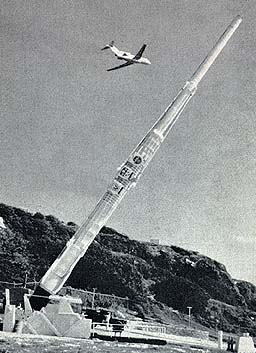HARP, for High Altitude Research Project, was a study of the upper atmosphere by instruments shot from a cannon. The project was conducted in the 1960s by scientists of the McGill University in Montreal, who named their vehicle the "Martlet", an old name for the martin bird; the shield of the McGill University in Montreal displays three red martlets. The cannon which propelled the Martlet to the high atmosphere was the creation of Gerald Bull, a Canadian engineer who specialized in the design of cannon. From the US Navy Bull obtained two cannon of the type used by battleships, with a 16-inch (40 cm) caliber, and combined them end-to-end to create a single tube of nearly twice the length. The cannon was mounted on the island of Barbados and fired nearly vertically, over the ocean. To reduce air resistance, the 200-lb Martlet vehicle was given a smaller diameter than 16 inches, with wooden blocks filling the space between it and the barrel. Because the payload and attachments were about 10 times lighter than the regular 16-inch shell, the acceleration was much larger, about 25,000 g: electric circuits had to be encased in plastic to resist the great forces. The peak altitude was extended (by 4 miles), by pumping out most of the air in the gun barrel before the shot. When the cannon fired--its loud bang was heard all over Barbados--the airtight cover over the muzzle was blown away and the Martlet rose into the high atmosphere, to altitudes of 80-90 miles. Unfortunately, cannons are also instruments of war, and Bull's specialization ultimately led to his death. He was assassinated in March 1990 at his home in Brussels, Belgium, apparently by agents of Israel, who had learned that he was helping Iraq build a "super-cannon" to use against Israel (still formally in war with Iraq, though the two share no border), some 300 miles away. Eight pieces of the barrel of that gun, ordered by Iraq in Europe and labeled as chemical industry components, were intercepted in Britain a few weeks afterwards, and other parts were seized by customs officials in Greece and Turkey. Following the "Desert Storm" war of 1991, the allies discovered in Iraq the site of the cannon itself. It was still incomplete, and it pointed towards Israel. |
